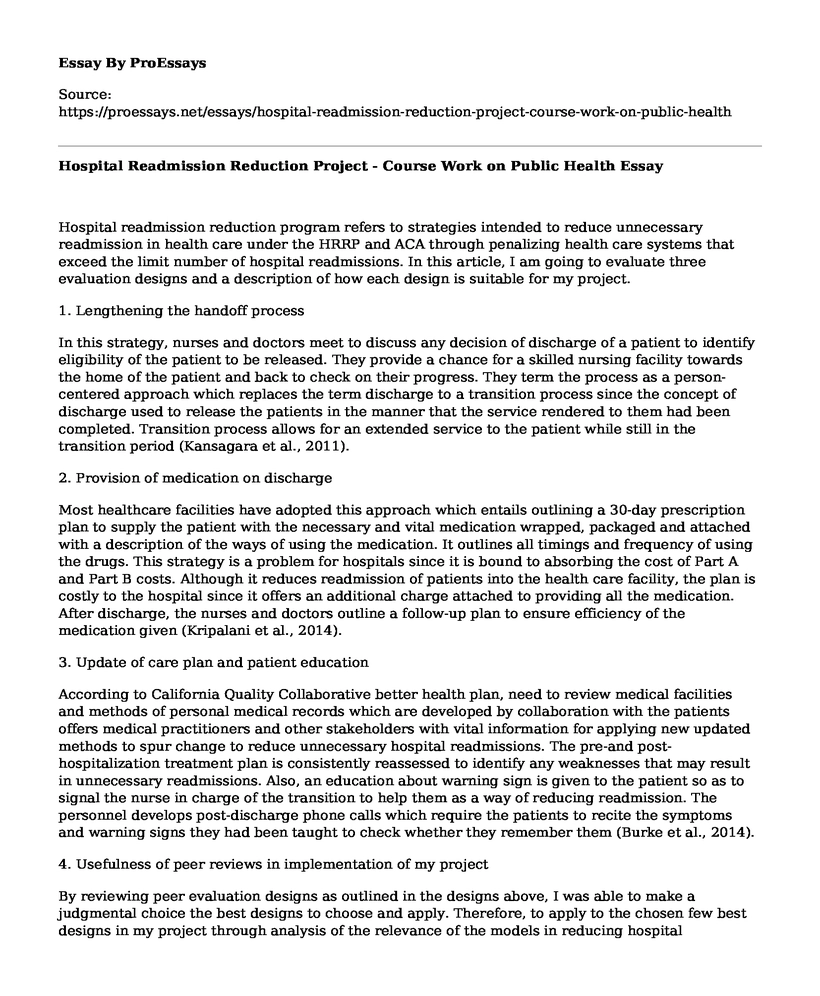Hospital readmission reduction program refers to strategies intended to reduce unnecessary readmission in health care under the HRRP and ACA through penalizing health care systems that exceed the limit number of hospital readmissions. In this article, I am going to evaluate three evaluation designs and a description of how each design is suitable for my project.
1. Lengthening the handoff process
In this strategy, nurses and doctors meet to discuss any decision of discharge of a patient to identify eligibility of the patient to be released. They provide a chance for a skilled nursing facility towards the home of the patient and back to check on their progress. They term the process as a person-centered approach which replaces the term discharge to a transition process since the concept of discharge used to release the patients in the manner that the service rendered to them had been completed. Transition process allows for an extended service to the patient while still in the transition period (Kansagara et al., 2011).
2. Provision of medication on discharge
Most healthcare facilities have adopted this approach which entails outlining a 30-day prescription plan to supply the patient with the necessary and vital medication wrapped, packaged and attached with a description of the ways of using the medication. It outlines all timings and frequency of using the drugs. This strategy is a problem for hospitals since it is bound to absorbing the cost of Part A and Part B costs. Although it reduces readmission of patients into the health care facility, the plan is costly to the hospital since it offers an additional charge attached to providing all the medication. After discharge, the nurses and doctors outline a follow-up plan to ensure efficiency of the medication given (Kripalani et al., 2014).
3. Update of care plan and patient education
According to California Quality Collaborative better health plan, need to review medical facilities and methods of personal medical records which are developed by collaboration with the patients offers medical practitioners and other stakeholders with vital information for applying new updated methods to spur change to reduce unnecessary hospital readmissions. The pre-and post-hospitalization treatment plan is consistently reassessed to identify any weaknesses that may result in unnecessary readmissions. Also, an education about warning sign is given to the patient so as to signal the nurse in charge of the transition to help them as a way of reducing readmission. The personnel develops post-discharge phone calls which require the patients to recite the symptoms and warning signs they had been taught to check whether they remember them (Burke et al., 2014).
4. Usefulness of peer reviews in implementation of my project
By reviewing peer evaluation designs as outlined in the designs above, I was able to make a judgmental choice the best designs to choose and apply. Therefore, to apply to the chosen few best designs in my project through analysis of the relevance of the models in reducing hospital readmissions. For instance, updating care plan and patient education and lengthening the handoff process and provision of medication on discharge are chosen few of the methods in my reduction project.
5. Relationship between readmission reduction project needs assessment findings with evaluation model
The hospital readmission reduction project needs assessment findings above are like a model for evaluation of the health care facility performance. This is because the health care will try to assess the relevance of their services through a follow-up plan that represents an evaluation model. The more the ineffectiveness of their service the more the facility will need to make another model change by use of needs assessment evaluation model.
References
Kripalani, S., Theobald, C. N., Anctil, B., & Vasilevskis, E. E. (2014). Reducing hospital readmission rates: current strategies and future directions. Annual review of medicine, 65, 471-485.
Kansagara, D., Englander, H., Salanitro, A., Kagen, D., Theobald, C., Freeman, M., & Kripalani, S. (2011). Risk prediction models for hospital readmission: a systematic review. Jama, 306(15), 1688-1698.
Burke, R. E., Guo, R., Prochazka, A. V., & Misky, G. J. (2014). Identifying keys to success in reducing readmissions using the ideal transitions in care framework. BMC health services research, 14(1), 423.
Cite this page
Hospital Readmission Reduction Project - Course Work on Public Health. (2021, Jun 24). Retrieved from https://proessays.net/essays/hospital-readmission-reduction-project-course-work-on-public-health
If you are the original author of this essay and no longer wish to have it published on the ProEssays website, please click below to request its removal:
- Wrong-Site Surgery Event
- The Worst Fat in the Food Supply - Public Health Essay Sample
- Paper Example on Health Facilities in South Carolina
- Essay Example on Doping in Sports: A Global Scourge That Must Be Eradicated
- Unlocking My Unique Walking Style to Learn New Moves - Essay Sample
- COVID-19: Impact Beyond Biology - A Global Crisis - Essay Sample
- Paper Example on Definition of Meaningful Use of HIT







